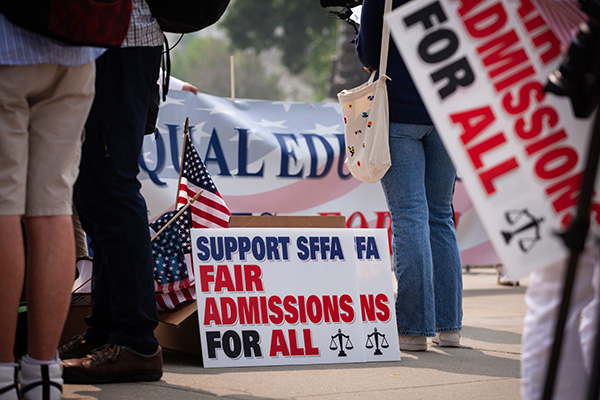Affirmative Action Decision Is a Mixed Victory
Gregory Hood, American Renaissance, June 29, 2023
Subscribe to future audio versions of AmRen articles here.
There is much weeping and gnashing of teeth because the Supreme Court ruled 6-3 against “affirmative action.” Justices Elena Kagan, Sonia Sotomayor, and Kentanji Brown Jackson dissented. The objection by the latter two justices is not surprising. It’s hard to believe they would be Supreme Court justices, judges, or perhaps even lawyers were it not for affirmative action.
Justice Jackson’s middling intellect was evident in her dissent.
Gulf-sized race-based gaps exist with respect to the health, wealth, and well-being of American citizens. They were created in the distant past, but have indisputably been passed down to the present day through the generations. Every moment these gaps persist is a moment in which this great country falls short of actualizing one of its foundational principles — the “self-evident” truth that all of us are created equal.
Of course, that is the problem. Racial gaps exist because the races do not perform equally. Justice Jackson appeals to Thomas Jefferson’s words but forgets that Jefferson himself thought blacks and whites could not and should not live under the same government.
Justice Jackson argues that “our nation has never been colorblind.” White advocates would agree. It was our misguided attempt to be colorblind that has led us to ruin. Obviously, this isn’t what she objects to. Instead, she argues that schools must confront inequality, which is transferred through generations. The fight for egalitarianism is “to the benefit of us all.” Why this is so remains unexplained.
The majority disagreed with Justice Jackson. Yet her reasoning is important. Race realism is necessary because one must have an explanation for inequality besides “discrimination.” The Court is right that the law mandates equal treatment and no racial discrimination, but this will not lead to equality. If we define racial equality as “no racial gaps,” it is an impossible goal. Indeed, if we accept Justice Jackson’s logic at face value, we must conclude that America is (and has always been) institutionally biased in favor of Asians at the expense of whites.
Justice Thomas, in a concurring opinion, forcefully argued for the “colorblind constitution” and the promise of the Fourteenth Amendment. In contrast to Justice Jackson, who wrote what is essentially a diary entry about her feelings, Justice Thomas drew on history and precedent to make his case. Though he made the occasional rhetorical flourish in favor of racial equality, he fundamentally argued about what the law says, rather than what it should say. “We cannot be guided by those who would desire less in our Constitution, or by those who would desire more,” he said.

June 29, 2023: Members of the Asian American Coalition for Education and the DC chapter of the Asian American Political Action Committee celebrate the US Supreme Court ruling that universities may not consider race in admissions. (Credit Image: © Allison Bailey/NurPhoto via ZUMA Press)
However, there is a major problem with today’s decision. The Supreme Court left open a big loophole in its ruling, which ensures affirmative action will probably persist. There might be no substantive changes at all. Chief Justice John Roberts, who has a long history of seeking compromise and defanging conservative rulings, included this in his decision: “Nothing in this opinion should be construed as prohibiting universities from considering an applicant’s discussion of how race affected his or her life, be it through discrimination, inspiration, or otherwise.”
The New York Times, in its breaking news coverage, says:
Minhal Nazeer, 17, a high school student in Louisville, Ky., who will be applying to colleges including Harvard and U.N.C. in the fall, said she would take advantage of the application essay to discuss her South Asian identity, something that Chief Justice John G. Roberts Jr. said universities could consider as long as they did not use it to replicate the current system of affirmative action. “I will be talking about my race in my applications to schools,” Nazeer said. “And I hope they recognize that as an integral part of my identity.”
Obviously, no white person would do such a thing, unless it was part of a self-flagellation ritual. A university recognizing a white person’s race as an “integral part” of his identity would not help.
Elite colleges and universities have already been eliminating standardized test scores and other metrics that allow relatively objective analysis of applicants. Instead, they are increasingly embracing subjective and frankly juvenile exercises that allow them to admit underqualified non-whites with progressive political views. Now, this trend will intensify.
What is really at stake is the way these new subjective metrics are interpreted. It would be instructive to see if a white student who wrote about his white identity would be punished. Of course, in today’s climate, it would take an extraordinarily courageous white student, a principled lawyer, and a judge who actually believes in the rule of law to examine anti-white discrimination truly. These may be in short supply.
Today was a victory, but a limited one. Stephen Miller of America First Legal probably had the best takeaway. He posted a tweet asking for those who are hurt by racial preferences to contact him. Let’s hope others will follow suit.
This was not an end, but a beginning. The legal actions are just a first step; they will not be enough. In fact, we will probably see universities become more explicitly anti-white as they shift admissions standards around political tests rather than academic credentials. Smart whites will continue to be discriminated against. More than ever, we need white identity politics, a defense of race realism, and a movement dedicated to championing the collective interests and self-determination of white people.















